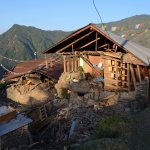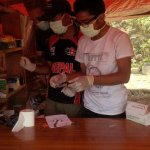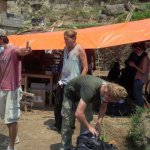Update on Nepal Relief Efforts
Thank you to everyone who supported the efforts of COE alumni in Nepal. Through your support we were able to raise approximately $8000 through Indiegogo and another $6000 through the COE website.
report from Michael Tamure:
Last September, during our trip to give a seminar weekend in Burlington, VT, our good friend, Nina Meyerhof, invited us to her home there to meet with her and some extraordinary people from around the world involved with global healing and transformation projects. Nina is not only respected the world over as a dedicated educator, author and Founder/Director of the Non-Profit Organization, Children of the Earth (a United Nations NGO), but is also the recipient of numerous awards ranging from The Mother Theresa Award to the International Educators Award for Peace. She and her organization work tirelessly to inspire and unite young people, through inner personal and outward social transformation, to create a peaceful and sustainable world.
One of the bright lights we met at Nina’s was Mark Harris, a 27 year-old Children of the Earth Alumnus, who hails from Toronto, Canada. A remarkable soul, he shared with me, at the time, his vision of establishing an art center in Sindupalchowk, Nepal, with his friend, David, as a sanctuary for artists and musicians to come to nurture their spirit and art, while offering simple programs for the local children. Merely six months later, the two of them had rented an old stone house near an idyllic valley there to realize that very vision. After three full weeks of renovating the house, they had their unofficial opening for their new creative art center. The very next day, on April 25 at 11:56 AM local time, the remote village of Sindupalchowk, along with much of Nepal, was devastated by a 7.8 magnitude earthquake and its aftershocks. Mark narrowly escaped being crushed beneath the collapsing stones of the building and chose to stay in Nepal to bring immediate and direct aid to those in the more remote areas, like Sindupalchowk, struggling to survive.

Mark’s understanding of the region and its people and lightning fast response have brought food, water, tents, medical aid and other necessities of survival to those in the greatest need in this region, which is amongst the hardest hit and most difficult to reach. In the past two weeks, the relief efforts that he has brought to these regions and its people are heaven-sent. He had immediately set up an Indiegogo account to collect donations, but, with the immediate response from Nina and Children of the Earth organization, he was able to have a much more direct route for donations to reach him. Nina was able to relay wire transfer of immediate cash for donations through Western Union, who waived all fees for aid to Nepal through her organization, so that Mark could procure the immediate necessities of food, water, shelter and medical aid to those most in need.
As traumatic and devastating as this earthquake has been, as with all grave misfortunes, however, the blessing that accompanies it has been that global attention and care are finally being directed toward Nepal and its people. This is of particular import for amongst the ranks of the Nepalese people are hidden some of the future global leaders being groomed in the spirit realms along with some of the current stewards of ancient wisdom. What happens in Nepal affects all of us around the globe regardless of our social, economic, religious or political differences. Here is an opportunity for those of us who are blessed to enjoy our home and our varied interests to help bridge the gap between heaven and earthly living.

from Mark Harris:
We arrived in Ichowk with our supplies, after a difficult ride up the mountain that saw guys frequently getting out of the jeeps to push the vehicles up the steep parts. Everywhere is devastated, and yet the mountains were as beautiful as ever. The villagers there told us that in this region of 1300 people the only aid that had arrived so far came from a helicopter that dropped three sacks of rice. That night we spoke with villagers explaining that we were not from an NGO, and that we were a group of independent people looking to help, and that our hope was to get some sort of medical camp started in Ichowk. Many people approached us with various wounds and ailments seeking treatment that we were unable to offer. There was an old woman with a badly infected hand and a younger man who had lost the use of his arm following the quake. We set up camp with one of the tarps we bought, ate some rice and sang some songs for the people who had gathered to meet us. People were dancing, singing and eating, and while a hail storm came through that night, and our sleep was a cold one, it was a fantastic experience.

The next day the locals in Ichowk set out to carry a portion of our rations to the next village of Dapshung with our group while a few of us returned to Kathmandu to prepare the next run of supplies. Back in Kathmandu I met up with two architects Rebecca and Roberto who had come from Mexico, originally to help us build art studios on David’s land, but now here to put up semi-permanent bamboos structures before the monsoon rolls in. The situation in Kathmandu is drastically different than that of the village. I found them at a backpacker’s hostel called Fireflies which has following the disaster turned into a hub of travellers coordinating relief efforts independently and often from their own savings. There’s a lot of well-intentioned people here, and it’s been an amazing resource and network that has led to exciting additions to our little group for Sindhupalchowk.
For instance, Rebecca and Roberto met a structural engineer from Spain who had been stranded in the Everest region for a few days following the quake. He was able to sit down and discuss issues with their proposed bamboo structures and offered suggestions. He is here with a geologist and has expressed interest in joining our team on our next trip to the villages. From the same hostel we were put into contact with a team of nurses and doctors from Germany who had arrived here with extensive supplies, skills and a will to do good, but weren’t exactly sure where to apply themselves. After some talks we convinced them to come to Ichowk on the promise that we would arrange their jeeps, food, security and accommodation.
We are quickly meeting all the right people and have created this international team of independent volunteers. To arrange the funding of this project, we partnered with a US-based NGO called Children of the Earth, a group who I had been involved with since they first invited me to a program in Nepal in 2006 on intercultural dialogue, spirituality, and peace building. They have raised funds from their side and have agreed to advance us the money we need while the campaign completes and processes. Thus far we have spent some $4,000 on food, fuel, and medicine, but for the amount of help that is needed here it seems we’ve hardly made a dent.
The plan today is to head back to the region with another round of supplies and to assess just what the government is offering to people and where, so as to not bring rations to places that already have enough. The architects will be joining today and will start immediately to build modular structures in the village of Dapshung both as model and as part of a more permanent camp. I will be heading only half-way before returning to Kathmandu tonight in order to organize these medics who are coming tomorrow to set up camp. There’s a sense that we have taken on more than we can handle, and I’m happy about that. Anything that stretches you as a person is growth.
from Mark Harris:
We finished our medical camp a few days ago, and came back to Kathmandu. During our time there we built a public washroom, provided care, and used one corner of the broken school house to offer some informal activities for the listless kids of the village. I brought with me some paint supplies and a guitar, and the kids of the village over the course of five days started painting the crumbling walls of their old school.
The first day we arrived a man approached us. He was no more than 25 years old. He said, "Brother, my wife and children died in the earthquake. Please don't sing songs while I am in mourning." We took heed to his request, and after two days he returned again. "Please sing me a song," he said. "I need something to make me happy during this sad time." This to me epitomized the soft aims of our relief project. While the primary goal was to do our small part to provide supplies, medical treatment and improve sanitation, the more important, but quieter goal was to help others move through the trauma. To shift from relief to recovery people must shift they way they identify themselves, from victims of the earthquake to survivors. One notable thing about the children painting the walls of the school was that so many of them drew houses. I know it's common for kids to draw houses and trees, but as all of these kids were now sleeping in makeshift shelters, these drawings seemed to have different implications.

Many NGO's and disater-profiteers have arrived in the region, and a lot of them have similar plans. For instance, I met one couple from California who used to run a voluntourism business in Ghana before Ebola scared away their volunteers and their revenue stream dried up. Seeing an opportunity in earthquake ravaged Nepal, they showed up to Melamchi unable to pronounce the name of the village where they hoped to send their voluntourists to build houses for people, and make a quick buck in the process. The problem I see with many of these approaches is the assumption that the providers of aid know what the recipients require often without consulting them, or considering the socio-cultural context in which they are working. We have tried to do things differently by responding to requests from local stakeholders instead of simply imposing our vision of help onto them.
from Mark Harris:
Yesterday I went to the UN house on the recommendation of a friend, to see if I could connect with the larger organizations involved in resetting displaced communities. I attended two cluster meetings, for emergency shelter and Camp coordination and Camp Management (CCCM). The meetings were held in a conference room at a government office and consisted of reps from major organizations like Oxfam, The World Bank, IOM, World Vision, and even the Canadian Armed Forces (who have sent medics and engineers) .
It was fascinating to see how these institutions work together to create strategies for disaster relief and crisis management, as we have been working independently of these bodies providing what help we can.
My primary intention was to go and find members of the international organization for migration to tell them of the two villages we've encountered that were in need of resettlement.
As I told them that I knew the region well and that I'd met two displaced communities, they asked us to return to the region with forms and a GPS reader to get exact coordinates for where these villages are, so that they can begin a geological study of the ground and locate a new spot for these people to live.
So today I'm heading back to Sindhupalchowk with more supplies, to check on the rebuilding of one school and to collect information on displaced communities.
In the coming days we will be buying solar chargers to bring up to remote areas in order to charge mobile phones and restore basic communication in the region.
Thanks again to everyone who has supported this project so far. Also if there is anyone interested in a week long trek through Gurkha region, message me.
from Mark Harris:
Update on Relief Efforts: We have now set up two medical camps, and have provided care to nearly 200 people in the last three days.

Our team has grown to include a doctor, nurses, paramedics and a handful of med students both from Nepal and Europe. We have built a medic camp in Ichowk, where we had first arrived to distribute aid, that has become a busy hub for people seeking care.
The camp affectionately known as Camp David consists of the "clinic" which is a tent with a couple shelves for medicine a table for paperwork and some mats on the ground to treat patients, a kitchen and some places to eat. The immediate need for first aid in the region is decreasing as more medics come in from abroad, but there are still pockets that have received little to no support.
Today our camp, which has grown to nearly 20 volunteers split into two groups, as one group moved forward into a particularly under-served village called Dapshung to set up a smaller first aid post and to rebuild the school from what materials we can salvage. We have heard that the earthquake has caused the land in Dapshung to crack and shift, and that in due time the entire village will be lost to a landslide. For this reason the school will be built up the hill in a safe area.
There are at least two villages in the region built in areas that are now uninhabitable due to the constant risk of landslides and rock falls (tremors are still happening daily). I imagine that these entire communities will need to be resettled somewhere in the country, but i can't imagine the kind of coordination that would require.
Our immediate priority and future plans is to provide both of these villages with supplies to build a temporary settlement, and to see if we can connect these communities with larger NGO's involved in the resettlement of displaced people.
Since we've started working here, running food, tarps, and medicine up to rural villages we've quickly watched the scale of this project grow, and have seen the various responses to the emergency from our grassroots approach to that off the World Food Program, and the UN. These larger international organizations tend to house their staff in 5-star hotel, drive fancy white SUV's and lack the common touch when dealing with local stakeholders, but they are extremely effective given that they are a team of experts with a massive budget. The past couple days I've seen huge convoys of supplies running through the region that absolutely dwarf our efforts, although they are arriving almost a week after us. As these groups flood the region with aid, we will be working on rebuilding efforts, because most groups are here to provide relief, after which they will leave behind a broken country.
Its in this space where there is work to be done.






















